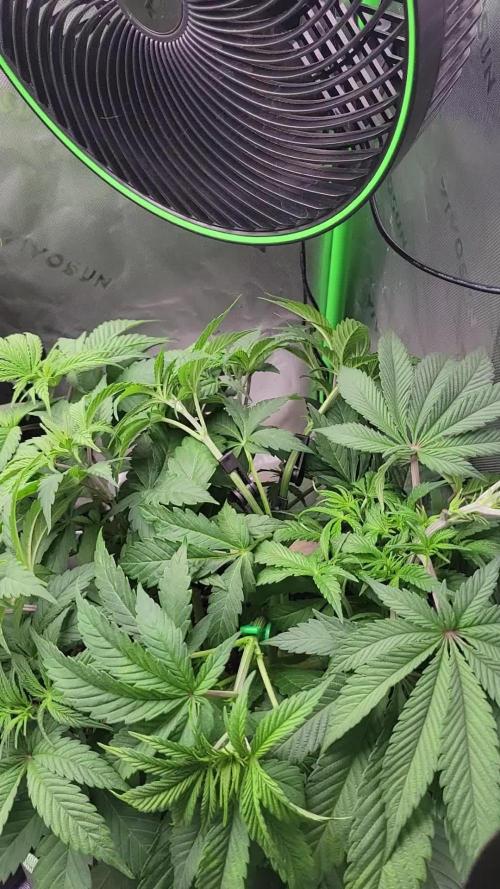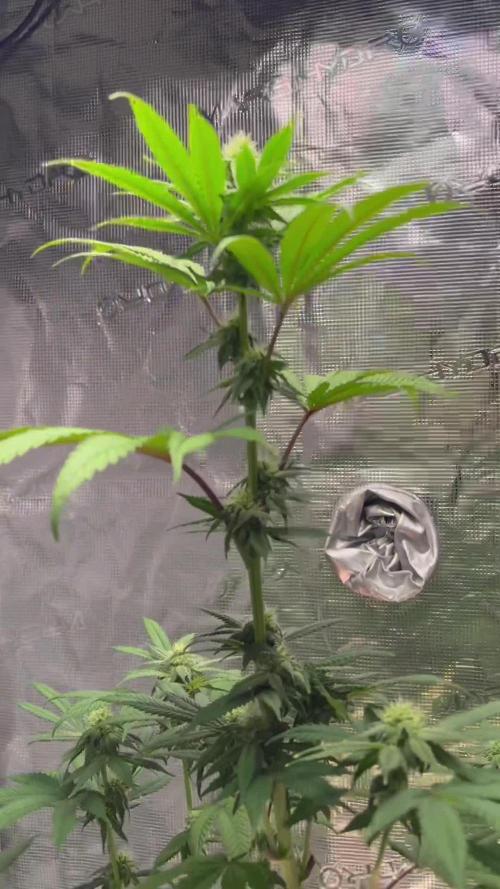The Grow Awards 2026 🏆 



































Likes
Comments
Share


@Creatorknbsland
Follow
Estão lindas essas meninas! Mais alguns dias e vão ter o grow so para elas! Mais 3 semanas de flora e de flora e boo!
Likes
18
Share


@Barcelona_Farmers710
Follow
Una experiencia realmente buena toda una gozada os la recomiendo Farmers!🍯🌈🍨🍓🍌
Likes
8
Share


@PavementPunk
Follow
Snapped the main branch a little but its been healing ok. Besides that shes been getting bigger filling out her new pot. Also took the smaller lowest branch for my first clone attempt. Probably gonna experiment with a couple more cuttings maybe even an auto clone for laughs. Been raising the light an inch at a time as i noticed signs of light stress. All in all good week happy growing friends
Likes
13
Share


@Kayotic
Follow
Zkittles
- Day 92 since sprouting
- Week 9 of flower
- Watering right now
- Buds are fattening up, leaves at top are changing color
- Super sticky and potent smell
Northern Lights INSIDE
- Day 88 since sprouting
- Week 8 of flower
- Watered Tuesday, 3 tsp Florabloom ( all I had)
-Great smell, very sticky
Northern Lights OUTSIDE
-Day 86 since sprouting
-Week 7 of flower
- Been in the 90's and very dry
- Watering multiple times a day with water from the hose
Likes
22
Share


@RDWCGrowing
Follow
1/25/2024 Vegetation Week 3 Day 1- took 2 Tops today and cleaned up a few lower leaves that were hanging down. The FiM seems to have worked well and looks like I have three branches coming in where it was FiMed.
1/26/2024 Vegetation Week 3 Day 2- took 2 Tops from the sides and took a little of the foliage that was touching the lid. She seems to be doing very well.. Water change day tomorrow.. YAY!! will get a good picture of the roots and see how she is doing.
1/27/2024 Vegetation Week 3 Day 3- Water Change Day! I noticed a slight red coming in on the STEMS which I added a pinch of EPSOM salt to help correct.
I added 36 Gallons of Water
I added the following Nutes:
Silica = .5Mil/Gal= 18Mil
CalMag= .75Mil/Gal= 27Mil
FloraMicro = 4.2Mil/Gal= 187Mil
FloraGro= 3.8Mil/Gal= 137Mil
FLoraBloom= 3.0Mil/Gal= 108Mil
ORCA = .5Mil/Gal= 18Mil
EPSOM- 1 big pinch
1/28/2024 Vegetation Week 3 Day 4- I cleaned her up just a little bit on stuff hanging down. I also made sure the PH is balanced so she could soak up the New Nutes.
1/29/2024 Vegetation Week 3 Day 5- I Got sick, Possibly food poisoned.. Luckily for me the system was able to do what it do and hold it down until I was feeling better.
1/30/2024 Vegetation Week 3 Day 6- I was still to sick to go to my grow room... Possibly food poisoned.. Luckily for me the system was able to do what it do and hold it down until I was feeling better.
1/31/2024 Vegetation Week 3 Day 7- First day back.. Her PH was down to 5.72 so I raised the PH back up closer to 6.0, I took a few pictures and got her height.. Feeling better through prayer so was able to get some pics today.
Likes
7
Share


@Ninjabuds
Follow
My ELUFAH UAP 1500 test grow is showing excellent results, with the plant thriving under my care. The addition of the ELUFAH Saturn Ring under canopy light has been a game-changer, significantly boosting growth. It's clear that the supplemental lighting is providing the plants with the extra energy they need for robust development and impressive yields.
Likes
51
Share


@Seldom_Seen
Follow
Day 36: Week 6 off to a start. Everything is looking good. Watered with nutrients(1ml SR, 4ml B). Only had 2ltrs ready and got no run off with this amount. Clipped off 5 or 6 of the lowest leaves that weren’t getting light.
Day 37: Watered again tonight as the soil felt dry. Same dose of nutrients as last night. Took 3ltrs before I had sufficient run off, she’s a thirsty one. Removed all ties for the moment bar the tie holding the main stem down but I did loosen this a bit. The plant is very wide so I want the branches to move in a bit as the grow up.
Day 38: I had to clip off a good few leaves. I know defoliation is a bad idea at this stage but the plant is very bushy and I’m finding damp patches on leaves.
Day 39: I put my hand on the pot tonight and I couldn’t believe how light it was. After taking 3ltrs only two nights ago, it took 4ltrs tonight. Watered with nutrients (1ml SR, 4ml B).
Day 41: Watered with nutrients (1ml SR, 4ml B). Still clipping one or two leaves each night because it’s so crowded in there. Plant looks very healthy.
Day 42: Six weeks old, where has the time gone. I remember it when it was just a seed. 😀. Plant grew 16cm this week.
Likes
13
Share


@BostonGreenParty
Follow
This week was a very easy one all that was involved was flushing. Flushing two separate times throughout the week involved tap water which was allowed to sit for 24 hours with air stones. Tap water was used first because the PPM of tap water is higher than RO water. Doing this avoids instant deprivation of food for plants, rather than cold turkeying them. As the last week arrives tap water will be replaced by RO water equating to 400PPM or less and given in abundance until PPM meter reads runoff at about the same 400PPM or less.
Likes
18
Share


@MrJones
Follow
Harvested Ganja Farmer Seeds / Mandarine XL Auto today, and put 263 grams of wet plant matter into the tent today, I tend to yield about 20% of that in the drying process, so we are looking at about 52 grams of finished weight flower, I am very pleased with the quality of what I harvested today, I would like to grow this again to see if I can push it further, the buds are thick and very hard, extremely resinous, the terpene profile is Sweet, Sour, Mandarin, Citrus fruits, I am looking forward to the smoke report!
Likes
12
Share


@PedroAndHisPlants
Follow
My first grow has been a great learning experience, and I couldn’t be happier with the results. From the reliable BioBizz soil and nutrients to the impressive performance of the Spider Farmer SF 1000, everything worked well together. Each component contributed to a successful harvest, and I’m excited to continue experimenting and improving my setup with new gear and techniques.💚
Likes
126
Share


@FoTwenny
Follow
Fo' Twenny Back with another update on this awesome little Northern Light Blue Auto from Delicious Seeds!
I have been giving plain tap water run through 2 KDF filters as of 9/5 and I moved her into the bloom room under quantum boards set on 12/12 to make room for the next run and maybe help her finish faster.
9/9 - She seems to be bulking up a bit in her last few days, but I waited a day too long to water and got she started to wilt/droop a bit. So, there are a few dead/brown leaves I've been having to pick out of her and thus begins pre-harvest defoliation.
9/13 - More defoliation and put her in a loosely sealed box to give 48-72 hours darkness. Harvest, coming soon.
9/15 - Checked her today and she could still use another day to dry out. I have never tried the darkness before harvest thing, but a lot of growers swear by it. So, I figure, why not? I will let her go until she is a bit drier and then give her the chop!
Thanks for checking out my diary. If you liked this diary, check out my other diaries and give me a follow!
Until next time...
Peace ☮️,
Love 💚,
And Frosty Nugs ❄️🌲!
-Fo'Twenny
Likes
19
Share


@Synthamesc
Follow
Almost the end of the week. I thought I'd put up a midweek post. First week of flower almost in the books and the stretch has started. Everything is going well so far. Nutes dialed in, plants happy, the green thumb is working its magic.
Likes
Comments
Share


@BeggarsBelief
Follow
Ultimately I want to go full organic but time is life's richest commodity, so it will probably be a few seasons before I get their. Also I don't have a drying setup which is a problem for this next run which is in week-1 rn (I go week one staring veg in my calendar). For drying / curing, I'm looking at fitting out a second hand wine fridge as I cant spend heavy on the Cure Puck or any of those auto fridge setups. Who knows maybe they come down in price. Peace out, happy growing to all.
Likes
48
Share


@DudeGrowsWeed
Follow
Growing Fast Buds Tangie'Matic again. This was one of the first strains I grew and I had great results the first time. Looking forward to seeing if I can up my game at all this time.
My Perpetual Harvest strategy…. Originally my plan was to start 2 seeds each month, but had some seeds from one breeder that did not germinate early in my rotation. Ultimately, this caused single seeds to pop and messed up my 2 at a time plans. But, that seemed to work out OK, because now I think starting one seed every 3 weeks is a better strategy. This should provide me with 4-5 plants at a time, instead of 6. However… Since I need to shut down over the summer because my tent is currently in the attic, I’m starting 2-3 seeds at at time for the last couple of rounds.
Plants get fed once weekly on weekends. Seedlings get water only. Plants in vegetation get water and Recharge. Flowering plants get water, Recharge or Big Bloom (Fox Farm). Feeding is done using 2 gallon watering can. Any additional waterings during the week are given on an as needed basis per plant. I lift the plants to help determine which plants are more dry (lighter) and provide water any plants via water bottles and watering spikes.
I give each pot a quarter turn every day in an effort to make sure the plants get equal lighting from all sides. I rotate the plant in place by turning the pot 90 degrees (I am not rearranging the layout of the plants in the tent on a daily basis).
The soil is an ‘organic super soil’ I mixed myself using organic top soil, organic potting soil, organic compost, organic peat moss, organic perlite, organic vermiculite, lime, epsom salt, expanded clay pellets and Jobe’s organic fast start. I am also recycling my soil and water with Recharge when using recycled soil.
For plant training I have tried a variety of things, but my plans now are to do LST bending only, no HST anymore. I may decide to go back to HST again in the future, but I’m curious to compare LST training only to see how that goes. Around week 3 I'll do a FIM pinch once there are 4-5 nodes established. And some defoliation around the 3rd week of flowering. I have been doing HST bending and having good results, but think the HST may be causing the plants to take longer to harvest. I hope FIM/defoliation only will help increase harvests while getting me to harvest sooner.
Setup:
1- Grow Tent 24”x48”x72”
2- Viparspectra 300W LED’s (1-V300 & 1-R300)
1- Hanging 100w CFL (26w actual)
1- Carbon Filter w/ 190cfm Fan & 4” ducts
1- 6” clip-on fan
1- 700w electric heater - oil filled radiator (in front of air intake behind tent)
Likes
Comments
Share


@Bread_n_Buds
Follow
Here our Zookies, as I anticipated, have started off great and are starting to give their best
In this diary you will find the plant that we will let grow straight, applying only a few techniques that do not involve cuts to preserve its speed characteristics. After taking the first fertilizers the plant is really doing very very well at a great pace and we expect great things the internodes are growing very well and we are practically almost in pre-flowering.
The other one you will find in the next diary worked with Topping / Main Lining / Main Folding
Comparison is the salt of experience.
We have started the Plagron fertilization program, we are in 100% organic configuration, the soil is recycled Promix + 1/3 fresh soil + 10% Perlite + RQS Mycorrhiza Mix (4gr in the mix, 1 gr under the small fiber pot).
We are administering // 1 ml/l of Power Roots - 1 ml/l of Pure Zym - 1 ml/l of Sugar Royal - 3 ml/l of Alga Grow
I have doubts about the compatibility of Pure Zym with mycorrhizae. If in doubt, ask the experts, do not mix too much at random.
https://plagron.com/en
The doubts about the compatibility Pure Zym / Mycorrhizae have been dispelled, they can go well together according to Plagron experts. If someone tells you that enzymes eat mycorrhizae, which in principle may seem possible, explain to them that it is not true.
https://www.royalqueenseeds.it/growing/452-easy-roots-mix-di-micorrhize.html
Try this variety, it is a top strain of the last few years very high level of thc ---- https://www.zamnesia.io/it/11174-zamnesia-seeds-zookies-auto.html
Brief description of Zamnesia // The result of the cross between Animal Cookies, GG#4 and ruderalis, this compact variety produces top quality buds, maintaining all the charm of a modern US hybrid. Thanks to the hard work of the Zamnesia genetics team, Zookies Automatic is easy to grow, fast flowering and exceptionally vigorous. Regardless of whether you grow indoors, outdoors or in a greenhouse, if you are looking for a stable autoflowering strain that is quick to harvest, Zookies Automatic is definitely the one for you.
Like all Zamnesia autoflowers, Zookies Auto promises rapid harvests of top-quality bud with minimal effort. And she delivers on that promise. After germination, Zookies Automatic plants grow vigorously for around 3–4 weeks. At the end of the pre-flowering phase, plants typically reach a height of between 90–110cm, depending on the size of the pot.
You can find the whole world of growing on Zamnesia and more, just check out the site and you will find "all the best that nature has to offer" in various shapes and colours.
The new strains are fantastic and the old ones are no exception... p.s. no hermaphrodites so far, can you growers say the same?
---- // www.zamnesia.com
Likes
29
Share


@MadeInGermany
Follow
Info:
Unfortunately, I had to find out that my account is used for fake pages in social media.
I am only active here on growdiaries.
I am not on facebook instagram twitter etc All accounts except this one are fake.
Flowering day 65
since time change
to 12/12 h.
Hey guys :-)
We arrived in the last days before the harvest 😊.
The buds have swollen again the last few days.
The trichomes are 90% milky and 10% amber 👍.
This week it was poured twice with 1.2 l each time (for nutrients, see table above).
As always, it is put in the darkroom for 48 hours before it is harvested.
There is still a harvest update and a final update after fermentation 👍.
Until then, I wish you all a lot of fun with the update and stay healthy 🙏🏻
You can buy this Nutrients at :
https://greenbuzzliquids.com/en/shop/
With the discount code: Made_in_Germany you get a discount of 15% on all products from an order value of 100 euros.
You can buy this Strain at :
https://www.amsterdamgenetics.com/product/kosher-tangie-kush/
Type:
Kosher Tangie Kush
☝️🏼
Genetics:
Kosher Kush
X
Tangie
👍
Vega lamp:
2 x Todogrow Led
Quantum Board 100 W
💡
Bloom Lamp :
2 x Todogrow Led
Cxb 3590 COB 3500 K 205W
💡💡☝️🏼
Soil :
Canna Coco Professional +
Nutrients :
Green Buzz Liquids :
Organic Grow Liquid
Organic Bloom Liquid
Organic more PK
More Roots
Fast Buds
Humic Acid Plus
Growzyme Big Fruits
Clean Fruits
Cal / Mag
Organic Ph - Pulver
☝️🏼🌱
Water: Osmosis water mixed with normal water (24 hours stale that the chlorine evaporates) to 0.2 EC. Add Cal / Mag to 0.4 Ec Ph with Organic Ph - to 5.8 - 6.4
Likes
10
Share


@CrazyFlowers07
Follow
Ciao a tutti oggi 3/06/2022 è il primo giorno di vita della pianta ✌️🏼✌️🏼 Buon seguimento 😝😝
Likes
34
Share


@Le_Duc_Du_Bud
Follow
Salut amis cultivateurs ✌️✂️🌿
Aujourd'hui je pose la nouvelle semaine 🗓️
Comment vous dire que je suis impressionnée ❗
Les plante ce développement a merveille voyait par vous même 🙏
Elles ont fortement grandi, je suis monter a 1.5L par plante, elle consomme la totalité des nutriments et me le montre très très bien 😍🤗
Merci Kannabia 🙏 encore des variétés merveilleuses 😊
J'espère que dame nature sera me récompense 🌿🍁
Pour plus d'informations par rapport à ces génétique, je vous laisse cliquer ici :
https://www.kannabia.com/fr





















